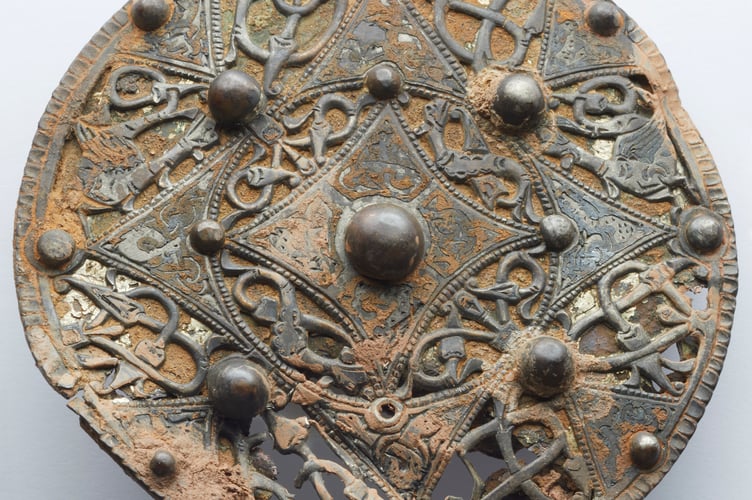A RARE early medieval brooch which lay hidden for many centuries is going on display later this month in the Museum of Somerset, in Taunton.
It comes from a time when the survival of Saxon Wessex was in doubt and Somerset provided a refuge in Athelney for King Alfred the Great.
Dating from about AD 800 to 900, the large silver and copper alloy disc brooch is well over a thousand years old and is one of the most important single objects ever found in the county.
Conservation work by Pieta Greaves, of Drakon Heritage, has removed centuries of corrosion and soil deposits to reveal the exceptional quality of its decoration.
Interlaced animal and plant designs in bright silver and black ‘niello’ are set against a gilded back panel.
The animals represented include wyverns – dragon-like creatures with two legs, wings, and long tails which would later become one of the symbols of Wessex.
Curator of archaeology Amal Khreisheh said: “Conservation has transformed this fascinating brooch and revealed the intricacies of its design.

“The fascinating details uncovered include fine scratches on the reverse which may have helped the maker to map out the design.
“A tiny contemporary mend on the beaded border suggests that the brooch was cherished by its owner and worn for an extended period of time before it was lost.
“We are very excited that we can show the brooch in the county where it was found and share it with people in Somerset and beyond through our programme of events.”
South West Heritage Trust chief executive Tom Mayberry said: “The Cheddar Brooch comes from a time that was a turning point in English history.
“In 878 Alfred the Great rallied his forces in Somerset and defeated the invading Danish army.
“Wessex was secure and the foundations had been laid for the creation of a unified English kingdom.
“We are delighted that this remarkable object is going on display at the Museum of Somerset.”
The brooch was found in 2020 by Iain Sansome while metal-detecting on farmland near Cheddar.
He reported it through the Portable Antiquities Scheme via his local finds liaison officer, who with the South West Heritage Trust organised a follow-up archaeological excavation of the findspot.
The brooch was acquired by the museum under the Treasure Act 1996 with support from the Arts Council England/V&A Purchase Grant Fund, the Art Fund, and the Friends of the Museum of Somerset.
Victoria and Albert Museum national programmes lead Leanne Manfredi said: “The Arts Council England/V&A Purchase Grant Fund supports the purchase of a wide range of material for the permanent collections of non-nationally funded organisations in England and Wales.
“We are delighted that the Trewhiddle-style Cheddar Brooch has been acquired by the Museum of Somerset via the British Museum’s Portable Antiquities Scheme.
“It will benefit audiences for years to come.”
Art Fund director Jenny Waldman said: “This remarkable piece of early medieval treasure has been hidden underground for many centuries.
“It is incredibly exciting that, after undertaking transformational conversation work, the brooch will soon be on display at the Museum of Somerset and shared with visitors as part of its collection.
“I am thrilled that Art Fund has been able to support this rare and important acquisition, all thanks to the generosity of our members and donors.”

British Museum portable antiquities and treasure head Michael Lewis said: “It is wonderful news that the Cheddar Brooch will now be on display for local people to see and enjoy.
“The British Museum is proud of its role, in partnership with the South West Heritage Trust, in delivering the Portable Antiquities Scheme in Somerset, so important finds like this are recorded and displayed.”
Arts Council England South West area director Phil Gibby said: “It is wonderful to see an object of such historic significance unveiled for the communities in and around Somerset to enjoy.
“As the national development agency for creativity and culture, at Arts Council England we are passionately invested in the care and public display of the country’s collections.
“We are committed to exploring new and accessible ways of engaging audiences with cultural heritage and proud to support the trust’s efforts through our national portfolio programme for 2023-26.
“Together, we are ensuring that the sub-region’s rich local heritage is preserved for generations to come.”
The Cheddar Brooch will be on display in the museum’s ‘Making Somerset’ gallery from Friday, October 20.
The museum is open Tuesday to Saturday from 10 am to 5 pm and entry is free.
A programme of talks and family activities is taking place over the autumn where people can find out more.
Five days of family activities relating to the Cheddar Brooch will be held during the schools October half-term: Saxon Reenactors (October 21), Make a Brooch (October 24 and 25), and Be an Archaeologist (October 26 and 27).
Ms Khreisheh will talk about the Cheddar Brooch on Friday, November 10, as part of the Museum of Somerset’s ‘Talk and Tea’ programme.
Mr Mayberry will give an evening talk on ‘King Alfred’s Somerset and the Cheddar Brooch’ on November 23.
The South West Heritage Trust is working with community partners in Cheddar to develop a programme of activities related to the Cheddar Brooch supported by the Arts Council England National Portfolio Organisation scheme.
This will culminate in a community event in Cheddar in the spring of 2024 when people will be able to see the brooch in the parish where it was found.
More information can be found by visiting the trust’s website here.




